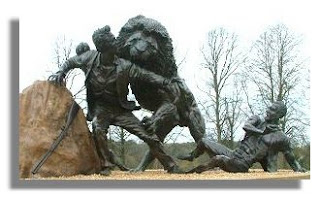It’s hard for me to know quite where to begin with regard to Harryhausen. Anyone who’s read my writing for any length of time may already know that the special-effects sorcerer, along with his great mentor Willis O’Brien (of King Kong) before him, was responsible for a really high percentage of the images that turned me into a movie lover.
Harryhausen was the greatest of the stop-motion animators, that small class of movie artists who photograph articulated puppets one frame at a time, then painstakingly move them the tiniest bit before shooting the next frame, to create the illusion of motion when the film is run at full speed. He hadn’t made one of his fantasy spectacles, made up of various set-piece sequences of monsters and other fanciful beings strung along an episodic plot, in over thirty years, since Clash of the Titans in 1981. He’d spent his long retirement sculpting—he designed this…
…dramatic statue of David Livingstone, his wife’s great-great-grandfather, in Blantyre, Scotland—doing interviews and DVD commentaries, playing small roles in John Landis movies, accepting awards and generally soaking up much-deserved adulation.
Computer-generated imagery had made him technically obsolete, but he never became aesthetically obsolete. Computer effects, even at their formidable best, have never had the warmth or soul of Harryhausen’s creations. In recent years stop-motion has been used almost exclusively for stylized, cartoony stories, like The Nightmare Before Christmas or the recent Frankenweenie and ParaNorman.
But the skittish, haywire, obsessive flavor of old-school stop-motion—the familiar “jerkiness” that resulted from each frame being a still image rather than a picture of a body in motion—meant that it had an air of whimsical stylization even when it was used in a supposedly realistic setting. I think that as kids, we loved stop-motion creatures not because they were so real but because they so obviously and enchantingly were not.
Harryhausen claimed that the director Eugene Lourie once told him that he always made his monsters die “like the tenor in an opera,” piteously rising and re-collapsing. I can attest that the death of the “Rhedosaur” at the end of The Beast From 20,000 Fathoms always put a lump in my throat when I was a kid. Here, perhaps, is a clue to what made Harryhausen special: I think he was, in a sense, an actor, channeling carefully-wrought performances into the faces and limbs of his models.
I defy anyone to watch several of his films together and not see distinctive personality types emerge from the “acting” of his creatures. He specialized in rampaging comic thugs, like the Cyclops in The 7th Voyage of Sinbad, the Ymir in 20 Million Miles to Earth, Talos in Jason and the Argonauts, the Kraken in Clash, or the Troglodyte in Sinbad and the Eye of the Tiger—slow-thinking, with loutish, irritable faces (subconscious parodies of the bullies who pick on the kind of little kid who grows up to be an animator, maybe?). He could also create manic, demonic characters, like his animate, sword-wielding skeletons, and animals, like the Rhedosaur, the title allosaurus in The Valley of Gwangi, or the Dragon in 7th Voyage, with its oddly canine manner—when I showed my kid that movie, she was furiously indignant at Sinbad for shooting this guileless beast with a giant arrow.
But that’s the point. All of these creatures, benign or menacing, were endearing, touched as they were both by the hands and the spirit of the unassuming California boy who gave them life. RIP to him—he may have come to a stop, but his creations will long remain in motion.










What a beautiful and heartfelt tribute. I too grew up on his movies. They were Saturday morning/afternoon TV staples -- particularly in Cleveland and Columbus.
ReplyDeleteGreatly appreciate the kind words. They were TV staples in Erie, PA, too, where I first saw them.
Delete